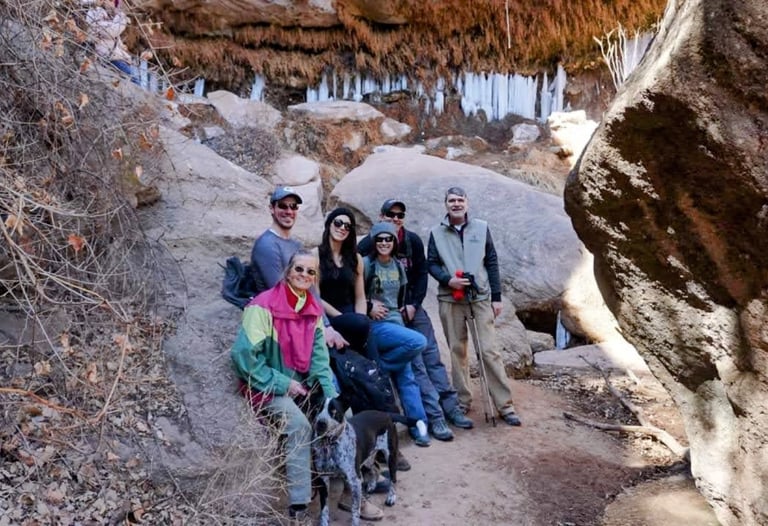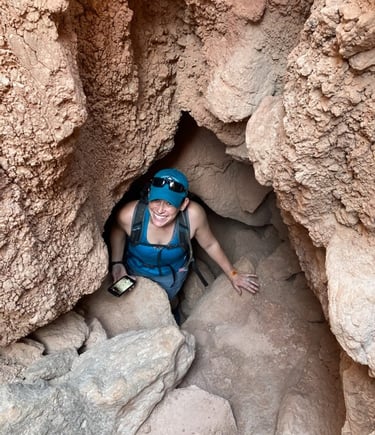Cave Week Day 5: Not All Caves Are Holes—Some Are Wounds in Stone
Unlike the deep, bat-filled caverns we've covered this week, Big Cave and Fern Cave in Palo Duro Canyon are shallow, side-carved erosion caves cut into the fiery red rock of Texas. They're not underground labyrinths—they’re exposed scars shaped by wind, rain, and time. With no bats inside (though plenty nearby), these caves highlight a wilder, sunlit form of geologic chaos—and we’re here for it.
CAVE WEEKCAVE & KARSTFERAL SCIENCEPALO DURO CANYONCAPROCK CANYON
6/5/20253 min read
When you hear “cave,” you probably picture a gaping hole in the ground that breathes like a monster, harbors ancient secrets, and smells like damp stone and bat guano. So far, we’ve talked about Wind Cave’s underground pressure systems, Mammoth’s endless dark highways, and Carlsbad’s subterranean cathedrals of limestone and guano. But let’s head to Texas—because today’s caves aren’t like the others. They’re not sinkholes or massive karst labyrinths. They're not vertical portals to the Earth’s core. These caves were carved sideways, not swallowed down.
Welcome to the red rock ferocity of Palo Duro Canyon—aka the "Grand Canyon of Texas," aka "Proof the Earth Was in a Mood When It Made the Southwest." Among its vivid cliffs and banded walls, you’ll find Big Cave and Fern Cave, which are less “voids of mystery” and more “ancient scars where time clawed away at the rock.”
🪨 How They Were Made (or More Accurately, How They Were Torn Open)
Unlike the limestone karst caves we’ve covered this week, Big and Fern Cave weren’t born from dissolving bedrock and slow acid-drip patience. These are erosion caves, sculpted over millennia by wind, water, and the relentless chaos of the elements. Layers of Triassic and Permian sandstone, siltstone, and shale got blasted by flash floods and gnawed by rain until hollows appeared like bite marks in the canyon walls.
They're not deep, but they are dramatic. Big Cave is a gash in the red cliffs you can walk into—wide and shallow, with walls that glow with iron-rich pigment under the sun. Fern Cave? A humid little microcosm tucked into the shady folds of the canyon, green and quiet, with maidenhair ferns defiantly growing where you’d think nothing would dare.
🦇 No Bats, But Don’t Worry—They’re Nearby
Unlike Wind or Carlsbad, you won’t find colonies of bats dropping from the ceiling here. That’s not because they’re absent—the canyon is full of them, including species like the cave myotis and the Mexican free-tailed bat. They just don’t roost in Big or Fern Cave. Instead, they claim crevices and sheltered canyon overhangs, tucking themselves safely away from the exposed drama of the red rock stage.
So don’t worry. You’re still being watched. Just not from overhead.
🌋 Geology That Slaps
Palo Duro’s geology is loud. It shouts in stripes—burnt orange, ochre, dusty white, blood red. The walls tell stories of shallow seas, desert dunes, and deep-time upheaval. You’re walking through layers of ancient chaos, tectonic tantrums, and sedimentary attitude. These aren’t caves born of quiet dissolution—they’re abrasion-born, violence-carved, open to the sky, and proud of it.
🌿 Biology in the Cracks
Fern Cave is a microhabitat wonder. Tucked into a shady alcove, it's cool and moist even in summer—letting ferns grow in defiance of the Texas sun. Lichens, mosses, canyon wrens, and rock squirrels keep the ecosystem humming. It’s not your gothic bat-cave biodiversity; it’s sun-blasted resilience at its finest.
🪶 Indigenous Roots
The canyon—and its caves—have long been sacred to Indigenous peoples, including the Comanche and Kiowa. These shelters offered more than shade; they were places of protection, memory, and power. The land itself holds meaning, the caves part of a broader cultural landscape where humans and Earth interacted with respect, survival, and deep connection.
⚒️ TL;DR: These Caves Rock Differently
Big Cave and Fern Cave may not stretch miles underground. They may not echo with the flutter of bat wings. But they are open wounds of geological memory, beautifully shallow scars that hold life, history, and the echo of ancient floods. They remind us that not all caves come from darkness below. Some are carved into the face of the Earth, wide open, weathered, and unbothered.
This is surface-level chaos—and we’re absolutely here for it.


Not all caves go down—some tear straight through time and red rock.


